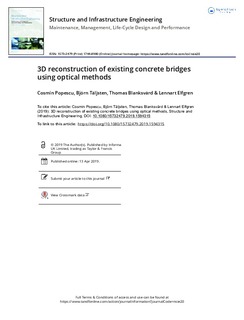3D reconstruction of existing concrete bridges using optical methods
Peer reviewed, Journal article
Published version
Permanent lenke
http://hdl.handle.net/11250/2640281Utgivelsesdato
2019Metadata
Vis full innførselSamlinger
- SINTEF Narvik [61]
Originalversjon
Structure and Infrastructure Engineering. 2019, 15 (7), 912-924. 10.1080/15732479.2019.1594315Sammendrag
Routine bridge inspections usually consist of visual observations. These inspections are time-consuming and subjective. There is a need to identify new inspection techniques for infrastructure that reduce traffic disturbance, and improve the efficiency and reliability of the acquired data. This study compared the performance of three different imaging technologies for the three-dimensional (3D) geometric modeling of existing structures: terrestrial laser scanning, close-range photogrammetry, and infrared scanning. Each technology was used to assess six existing concrete railway bridges. The technologies were compared in terms of geometric deviations, visualization capabilities, the level of the inspector’s experience, and degree of automation. The results suggest that all methods investigated can be used to create 3D models, however, with different level of completeness. Measurements such as span length, deck widths, etc. can be extracted with good accuracy. Although promising, a full off-site inspection is currently not feasible as some areas of the bridges were difficult to capture mainly due to restricted access and narrow spaces. Measurements based on terrestrial laser scanning were closer to the reality compared to photogrammetry and infrared scanning. The study indicates the no special training is needed for photogrammetry and infrared scanning to generate a 3D geometric model.
